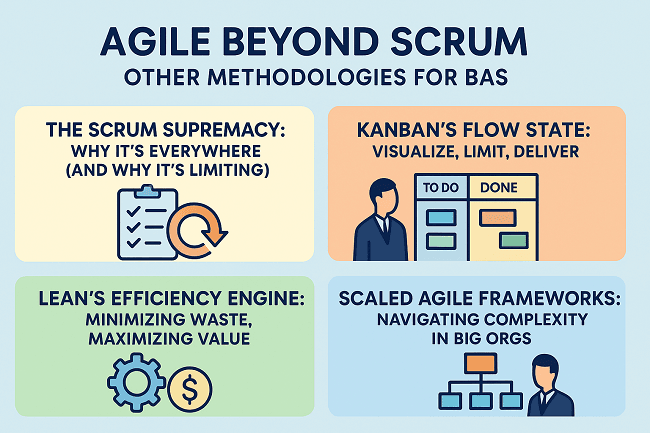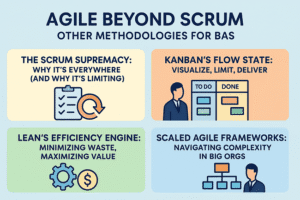Introduction: Expanding the Agile Horizon
Many Business Analysts (BAs) today work within Scrum frameworks — sprint planning, daily stand-ups, and retrospectives have become part of everyday vocabulary. But Agile is much broader than Scrum. Limiting yourself to one framework can restrict your effectiveness, especially in dynamic project environments where flexibility is key.
As the Agile ecosystem evolves, BAs must expand their toolkit to include Kanban, Lean, and Scaled Agile frameworks such as SAFe, LeSS, and Nexus. Understanding these methodologies helps BAs choose the right approach depending on project size, team structure, and delivery goals.
👉 If you’re a BA seeking to future-proof your career, exploring these alternatives is no longer optional — it’s essential.
The Scrum Supremacy: Why It’s Everywhere (and Why It’s Limiting)
Why Scrum Became Popular
Scrum is simple, structured, and effective for small, cross-functional teams. It emphasizes iterative development and rapid feedback, making it perfect for product-based organizations.
For BAs, Scrum provides clarity through defined ceremonies:
Sprint Planning: Helps translate business needs into user stories.
Daily Stand-ups: Keep communication transparent.
Sprint Reviews: Allow BAs to confirm stakeholder expectations.
However, despite its popularity, Scrum isn’t a one-size-fits-all solution.
When Scrum Hinders BA Effectiveness
Scrum can become restrictive when:
Teams handle unpredictable workloads (like support or operations projects).
Organizations operate in multi-team environments where coordination is complex.
Continuous flow or frequent releases are critical (e.g., DevOps pipelines).
Real-World Scenario
A BA in a financial institution noticed that constant production fixes were interrupting Scrum sprints. The rigid two-week sprint cadence slowed down response times. After analysis, the team shifted to Kanban, allowing continuous flow without the burden of sprint planning — significantly improving delivery speed.
👉 Lesson: A skilled BA identifies when Scrum works — and when it doesn’t.
Kanban’s Flow State: Visualize, Limit, Deliver
What is Kanban?
Kanban is a visual workflow management system that promotes continuous delivery and work-in-progress (WIP) limits. Unlike Scrum, it doesn’t prescribe fixed iterations. Instead, tasks flow smoothly from “To Do” to “Done.”
BA’s Role in Kanban
Business Analysts are crucial in defining and refining workflow policies:
Defining Work Items: Categorize requests, change requests, or production bugs.
Setting WIP Limits: Prevent bottlenecks by balancing team capacity.
Tracking Metrics: Use Lead Time and Cycle Time for process improvement.
Real-World Example
At an IT service firm, a BA used Kanban boards (via Jira) to manage application maintenance requests. By visualizing tasks and enforcing WIP limits, the BA reduced turnaround time by 40%. Stakeholders gained transparency, and the team avoided burnout.
Learn More
For deeper insights into Kanban principles, visit Kanban.org.
Lean’s Efficiency Engine: Minimizing Waste, Maximizing Value
Understanding Lean Principles
Lean focuses on maximizing customer value while minimizing waste. Originating from Toyota’s production system, Lean principles have been widely adopted in software and business analysis.
The BA as a Waste Detective
A BA applies Lean by:
Identifying non-value-add activities like redundant approvals.
Reducing handoffs between departments.
Enhancing feedback loops between business and IT.
Lean Tools for BAs
Value Stream Mapping (VSM): Helps visualize and analyze the flow of materials and information.
Kaizen: Continuous improvement mindset for incremental change.
Scenario Example
In a healthcare project, the BA conducted a Value Stream Mapping workshop and discovered that 25% of time was wasted in manual claim verifications. Automating this step saved the client both time and cost — a perfect demonstration of Lean thinking in action.
👉 Check out more on Lean concepts from the Lean Enterprise Institute.
Scaled Agile Frameworks: Navigating Complexity in Big Organizations
Why Scaled Agile?
When multiple teams work on interconnected components, a single Scrum framework can’t handle the coordination. That’s where Scaled Agile Frameworks (SAFe, LeSS, Nexus) come in.
SAFe 6.0 and the BA Role
In SAFe 6.0, BAs:
Contribute to Program Increments (PIs) — large planning sessions aligning multiple teams.
Work within Solution Trains to ensure alignment between business strategy and delivery.
Collaborate on Feature Breakdown, ensuring requirements flow from strategic themes down to user stories.
Real-World Scenario
A BA working on a telecom program with 10+ Scrum teams used SAFe to align product vision with team-level execution. During PI Planning, the BA clarified dependencies and ensured every user story tied back to a business objective — minimizing rework and confusion.
Other Frameworks
LeSS (Large-Scale Scrum): Extends Scrum principles across multiple teams.
Nexus: Adds integration layers for teams working on a single product.
For more details, visit the Scaled Agile Framework official site.
Your Agile Future: Choosing the Right Tool for the Job
Hybrid Agile Models
In practice, most organizations adopt a hybrid approach — combining Scrum, Kanban, and Lean elements.
Example:
A product team may use Scrum for feature development.
The same team uses Kanban for production support.
Lean principles guide overall process efficiency.
A Business Analyst who can recommend and tailor these combinations becomes a strategic advisor, not just a requirements gatherer.
The Adaptive BA
To succeed in diverse environments, the adaptive BA should:
Assess project context (team size, goals, constraints).
Understand multiple frameworks and select the best fit.
Promote continuous learning through certification and community engagement.
Pro Tip: Certifications like ICAgile’s Agile Analysis Certification (IIBA-AAC) can boost your credibility and deepen your understanding of advanced Agile methods.
Continuous Learning: Staying Ahead of the Curve
The Agile world is evolving rapidly. With each new release — such as SAFe 6.0 — roles, ceremonies, and practices are being refined. Business Analysts must stay updated through:
Communities of Practice (CoP) in their organizations.
Webinars and courses from IIBA, PMI, or Scaled Agile.
Reading resources like Agile Alliance or bacareers.in for practical BA insights.
Conclusion
Scrum may have started your Agile journey, but true mastery lies in understanding the entire Agile landscape. From Kanban’s visual flow to Lean’s waste reduction and SAFe’s scalability, each framework equips Business Analysts with tools to adapt, collaborate, and deliver higher business value.
The modern BA is no longer limited to gathering requirements — they’re strategic enablers of agility.
🌟 The more methodologies you master, the more valuable you become to your organization.
Related Articles:

Business Analyst , Functional Consultant, Provide Training on Business Analysis and SDLC Methodologies.


